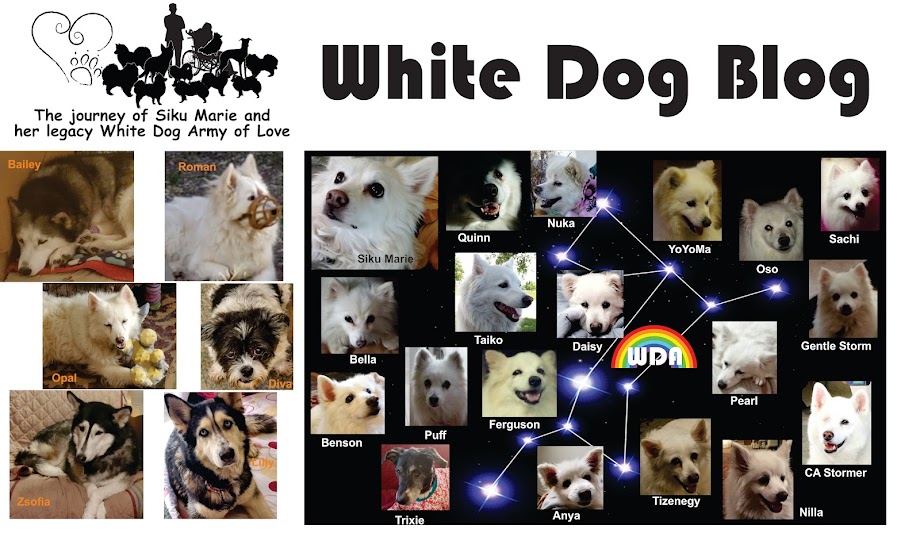White Dog, Quinn, Nuka and Puff have gained a new respect for the challenges faced by those who have difficulties in seeing since YoYoMa joined us two months ago this weekend. We are all amazed at his memory and ability to get around but we still cringe when he slams into a halfway open door and we sometimes snap when he stumbles into us when we are sleeping. For humans the challenges are even more daunting as they travel on public transportation, cross busy streets unattended, and carry on through the obstacles of daily life. Guide Dogs are heaven sent angels for humans with impaired sight and the dogs are remarkable in the second sight they provide, but sometimes these four-legged heroes don’t fit the bill. New technology is being developed which will release the impaired from the limits imposed by their disability and someday soon a better world will be possible for them.
Researchers Create Robotic Aids for Visually Impaired June, 2011 Robert Bradford, University of Southern California
For the visually impaired, navigating city streets or neighborhoods has constant challenges. And the reality is that a significant number of such people must rely on a rudimentary technology - a simple cane - to find their way through a world filled with obstacles.
A group of USC Viterbi School of Engineering researchers is working to change this by developing a robotic, vision-based mobility aid for the visually impaired.. For the USC Viterbi team, the need is clear. According to the World Health Organization, 39 million people worldwide are totally blind and a much larger number, 284 million, are visually impaired. In the United States, according to the American Foundation for the Blind, 109,000 visually impaired people use long white canes to get around. Guide dogs? About 7,000 nationwide.
Gérard Medioni, professor in the Institute for Robotics and Intelligent Systems at USC Viterbi and his colleagues have developed software that “sees” the world and linked it to a system that provides tactile messages to alert users about objects in their paths.
The system uses Simultaneous Localization and Mapping software to build three-dimensional maps of the environment and to identify a safe path through obstacles. The route information is conveyed to the user through a guide vest that includes four micro-motors located on an individual’s shoulder and waist that vibrate like cell phones. For example, when a vibration on the left shoulder indicates a higher object to the left, such as a low-hanging branch, the individual can use that information to take a new path. Medioni said that canes have clear limitations with larger objects, from walls to concrete structures, and the technology will enable users to avoid falls and injuries.
Medioni is pleased with the prototype of the system presented on May 1 at the 2011 meeting of Association for Research in Vision and Ophthalmology. But he and the team now are attempting to improve it. The current head-mounted camera is bulky, and the team is working on a micro-camera system that could be attached to glasses. The goal is to have a new system in place by the end of this year.
White Dog and The White Dog Army imagine a day soon when the blind can “see” and be able to enjoy walking through the Park, dancing in the rain, hiking through a pine forest. They imagine lives lived without inconvenience and fear. They see a wonderful world that all can enjoy.


12 comments:
It all sounds wonderful. So many new and exciting advances in medicine for people and pets :)
Wyatt and Stanzie
Wow, wouldn't all of that be so wonderful - just imagine how it could change so many lives for the better!!!
Woos ~ Phantom, Thunder, and Ciara
This is amazing!!! It's so good to read hopeful news (when so much of the news is not so positive.
Your pal, Pip
What great news!!! We cringe at the thought of sweet YoYo running into a door.:(
Love,
Teddy Bear & Sierra
hey White Dog Army,
It certainly would be great if that technology came to be! Humans and dogs would totally benefit, so paws crossed it becomes an affordable reality!
Sorry that YoYoMa still sometimes has mistakes. Poor little guy! I am sure, though, that soon he will have the lay of the land, so to woof, and be able to maneuver with ease without getting hurt or bumps along the way. You go, YoYoMa!!
Suka
p.s. Thanks for your warm thoughts! :->
That is wonderful - it'd change the world!
Pepsi
YoYoMa is an amazing one fur sure and perhaps the world is normal to her. I just know she can feel us smiling at the love she receives!
Technology is great. We follow Blind Cat Rescue online and are amazed to watch their video - we are sure it is like watching YoYoMa - just amazing to see them navigate knowing they can't see.
YoYoMa is so amazing. And we just love when science and technology are used for such wonderful things.
It always amazes me the things that they can come up with and do to help in the medical field.
You also asked if we were walking this year, we haven't heard when/where our walk would be but most likely will. :)
Thank you for keeping us informed.
Sometimes in our busy lives ,, we forget to see what is important,, and thank goodness for those like you to keep us informed.
love
tweedles
Yay for innovation and advancement!
I'm sorry to hear about YoYo bumping into doors. It must be painful to see. But dogs are incredibly resilient. You are so wonderful to have taken him into your family.
Post a Comment